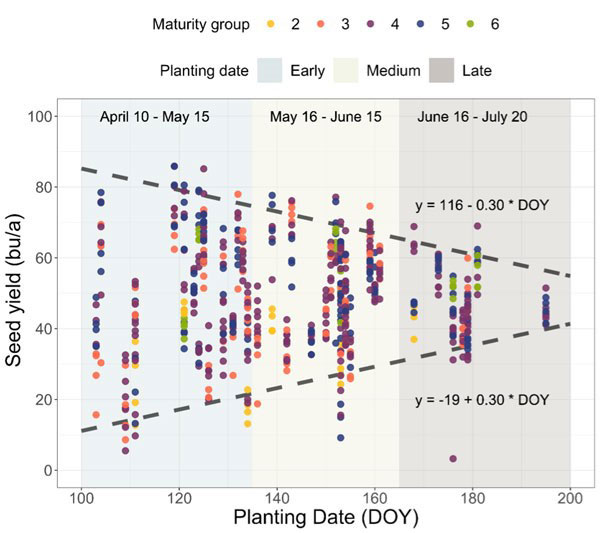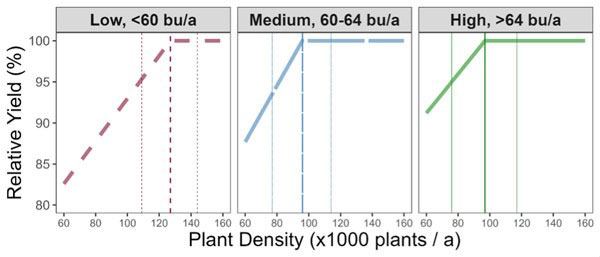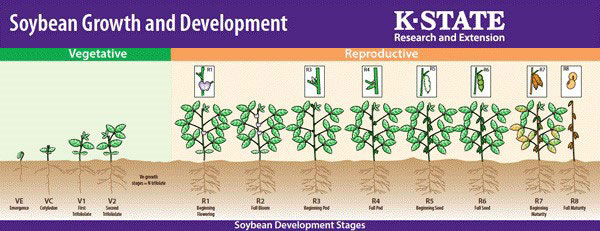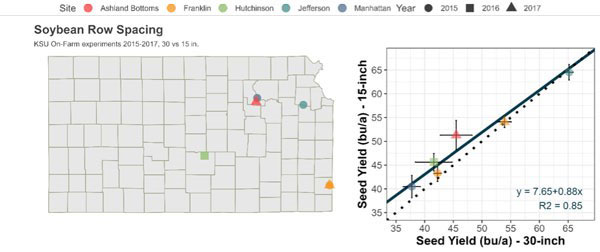Considerations for Late Planting
Where soybean planting has been delayed (or in double-crop soybean systems), producers should consider a few key management practices. Planting soybeans in the right soil conditions is essential for establishing an adequate soybean canopy and improving the chances of increasing the yield potential.
Planting date and maturity group
By planting in early June, soybeans are expected to bloom and fill seed from mid-August to mid-September, when nights are cooler, and the worst of heat and drought stress is usually over.
From mid-April to mid-July, we may expect maximum soybean yield in Kansas to be reduced by about 0.3 bu/a per day of delay past mid-April, from yield levels of about 80-90 bu/a to ~50 bu/a (Figure 3). On the other hand, the yield variability range is expected to narrow as the planting date is delayed, which may result in improved yield “stability” for late-planted soybeans (although achieving a lower maximum yield). More information related to this topic available at https://eupdate.agronomy.ksu.edu/article/soybean-planting-date-and-maturity-group-selection-585-6

Soybean seed yields as a function of planting date from Early (mid-April to mid-May) to Medium (mid-May to mid-June) to Late (mid-June to mid-July) for a diverse set of maturity groups (from Maturity Group 2 to 6).
Seeding rate and plant density
Increasing the seeding rate of late-planted soybeans by 10-20% compared to the optimal seeding rate can help compensate for the shortened growing conditions. Under normal conditions, the same soybean cultivar planted early in the planting window will develop nearly 50% more productive nodes than when planted in late June: 19-25 nodes when planted early vs. 13-16 nodes when planted late.
Soybean emergence could be delayed or compromised where there has been an excessive amount of rainfall in recent weeks. Replanting soybeans should be reserved only for exceptional cases where the stand counts and the uniformity look seriously affected. Otherwise, the cost of replanting is unlikely to pay off. Initial assessments should be done by the cotyledon stage (VC) and a week or so after the initial damage to assess the overall condition of plants and potential issues related to lack of uniformity, which could be a problem when stands are severely reduced.
Ensuring final plant populations are not too far from the optimal levels is crucial. In medium and high-yield environments, yields begin to decline at stands of less than ~100,000 plants per acre. In low-yield environments, however, yields may begin to decline at stands of less than ~125,000 plants per acre. At optimal planting dates, yields can be reduced by up to 15% with a stand of 80,000 plants per acre. This may be exacerbated under late planting dates due to the reduced capacity of the plants to produce compensatory yield growth, for example via branches.

Expected soybean relative yield (%) with respect to the optimal plant density by yield environment. Vertical lines indicate expected optimal plant densities (Low: 127,000 plants/a; Medium: 96,000 plants/a; High: 97,000 plants/a) and their corresponding uncertainty (95% intervals). Adapted from Carciochi et al. (2018).
Information on late-planted soybeans across multiple row spacing suggests that narrow rows (e.g. 7” or 15” vs. 30”) can hasten canopy closure, increasing season-long light interception, weed suppression, and potentially improving biomass and final yield. The likelihood of a positive yield response to narrow rows increases as the yield environment lowers (Figure 5), for example with delayed planting.
Row Spacing
On-farm experiments on soybean row spacing comparing conventional (30-inch) vs. narrow rows (15-inch). Collaborators: Kansas State University, United Soybean Board, North Central Soybean Research Program.
Finally, properly identifying soybean growth stages can make a difference in yield. Consult the soybean growth and development chart at:
https://www.bookstore.ksre.ksu.edu/pubs/MF3339.pdf







